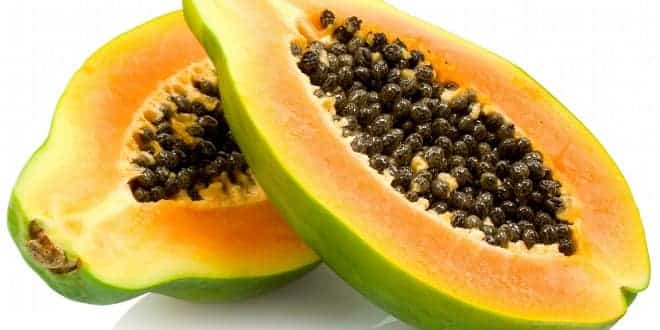Papaya
Paw paw
Papaw
Family Caricaceae
Genus Carica
Species papaya
Papaya Readings(On web page)
Nishina et al., 2000.
Papaya Production in Hawaii.
CTAHR, F&N-3.
Manshardt, 1999.
‘UH Rainbow’ Papaya. A High-Quality Hybrid with Genetically Engineered Disease Resistance.
CTAHR, NPH-1
Kempler and Kabaluk. 1996.
Babaco (Carica pentagona Heilb.): A possible crop for the greenhouse.
HortScience 31:785-788.
Carica
20 species
papaya
Lowland cultivated spp
Not found outside cultivation
Perhaps hybrid form
Only polygamous spp
Most important commercially
Other Cultivated Carica
Highland species
Common in upland Valleys of Ecuador and Colombia
Taste different, less sweet
Soups, stews, sweets, fresh
Genes for breeding (cold/disease resistance)
Other cultivated Carica
Hybrid types – Babaco
Most commercially advanced
Seedless – parthenocarpic
Large fruit
Fresh or stewed
Vegetatively propagated
Origin of Papaya
Origin of Carica papaya
Tropical America
Southern Mexico
West Indies
Other spp: Mexico – Argentina
Spread via seed
1600s in Asian tropics
By 1800 common in Pacific
Papaya Production in the World
Papaya per Capita Production in the World
World Production of Papaya
World Production of Papaya
World Yields of Papaya
USA Production
Most in Hawaii
Produce 23,000 MT
Most exported to mainland USA, Canada, and Japan
Production decrease since 1989 due to Papaya ringspot
Fruiting of the Papaya
Fruit hang along trunk
Flower in leaf axils
Most are dioecious
Some are hermaphroditic or perfect flowered
Five classes of flowers
Type I or Pistillate Flower
Female Papaya Flower
Type II or Pentandria Flower
Type III or Intermediate Flower
Type IV or Hermaphroditic Flower
Hermaphroditic Papaya Flower
Type V or Staminate Flower
Male Papaya Flower
Importance of Sex
Female
Fruit is an enlarged ovary
Male
Need pollen for pollination
Flower type influences
Thickness of flesh
Fruit shape
Inheritance of Sex
One locus, three alleles
M1 male
M2 hermaphrodite or bisexual
m female
Homozygous dominant lethal
M1M1, M1M2 and M2M2 lethal
M1m = male M2m = bisexual
mm = female
Seedlings segregate for sex
Need to maximize the number of productive plants
Hermaphroditic varieties maximize hermaphrodites
Dioecious type maximize females
Plant multiple seedlings per space and rogue wrong sex
Maximize Bearing PlantsHermphroditic variety
Want hermaphroditic plants
Rogue out females
1 per space = 67%
2 per space = 89%
3 per space = 96%
Female or Dioecious Types
Need one male for every 12-15 females
6-8% males
Fruit is better if good pollination
Pollination by wind and moths
Maximize Bearing PlantsDioecious variety
Maximize females
Rogue out males
1 per space = 50%
2 per space = 75%
3 per space = 87.5%
4 per space = 93.7%
Sex Can Change!
Too cool, wet, and high N
Female
Stamens become carpel like
Too hot, dry, and low N
Male
Ovaries fail to develop
Climatic Restrictions
Optimal temperature 22 – 26 C
Sex expression shifts
Flavor poor if cool
Die if less than -1C
Die if greater than 44C
Long growing season
Susceptible to wind damage
Cultural Restrictions
Need direct sunlight
Poor flavor if shaded
Well drained soils
Sensitive to waterlogging
Susceptible to Phytophthora
Sensitive to saline conditions
Diseases of Papaya
Papaya ringspot virus
Most important
Limiting factor in many areas of world
Mildew
Anthracnose
Root rot, Phytophthora (replant sites)
Nematodes
Papaya Ringspot Virus
Vectored by aphids
Leaf mottling and distortion
Reduce growth, yield
So severe in Florida that plants are grown as annuals
Papaya Ringspot Virus
Papaya Ringspot Virus
UH Sunup and UH Rainbow
GMOs (Genetically Modified Organism)
Insect Pests
Fruit flies
Webworms
White flies
Thrips
Mites
Fruit spotting bugs
Fruit flies
Papaya VarietiesTwo Major Types
Hawaiian – Solo types
Hermaphroditic
Smaller fruit, about 1 lb
Mexican or “fruta bomba”
Dioecious
Larger fruit, up to 10 lbs
Hawaiian VarietiesHermaphroditic Solo types
Common in US markets
Fruit small, firm, sweet
Plant smaller ~ 8’
Sex expression more stable
Series of inbred seed lines developed in Hawaii
Most widely grown is “Sunrise” variety
Mexican Varieties
Locally available in many tropical regions
Much larger fruit
Flavor generally less intense
Frequently dioecious
Not as good for shipping
Establishment
Propagated by seed
Clean off gelatinous coat
Dry and plant immediately
Warm (80 F), sterile soil
Germinate in 2 weeks
In 10 weeks ready to transplant
Site Selection
“Virgin soil” preferred
Replant sites
High levels of Phytophthera palmivora
“Virgin soil” technique
Fungicide drench in planting hole
Fallow of 3-5 years
Planting
Spacing
Single row, 8’ x 10’
(435 plants per acre)
Double row, 6’ x 6’ x 12’
(850 plants per acre)
Multiple seedlings per space to maximize bearing plants
3 to 5 plants per hole until flowering
Cropping Cycle
From planting begin to fruit in 10-12 months
Begins to flower in 4-8 months
Fruit develops in 4-6 months
Possible to grow as annual
Commercially can fruit for 3-4 years
Production Practices
No pruning
High nitrogen to encourage growth
May thin fruit to one per cluster to avoid crowding
Harvesting and Yields
Climacteric fruit
Harvest yellow green
Dark green fruit will not ripen
Potential yield
100 tons/ha or 40 tons/acre
Average yield
15-25 tons/ha or 6-10 tons/acre
World Yields of Papaya
Post Harvest
Storage
1-3 weeks @ 7-10C
Fruit fly infestation treatment
Hot water: 20 minutes @ 120F
Hot air: heat fruit flesh to 117F
International Markets
Major exporting countries
Mexico to USA and Canada
Brazil to Europe
India to Middle East
Many others
Any Questions about Papaya?
…

